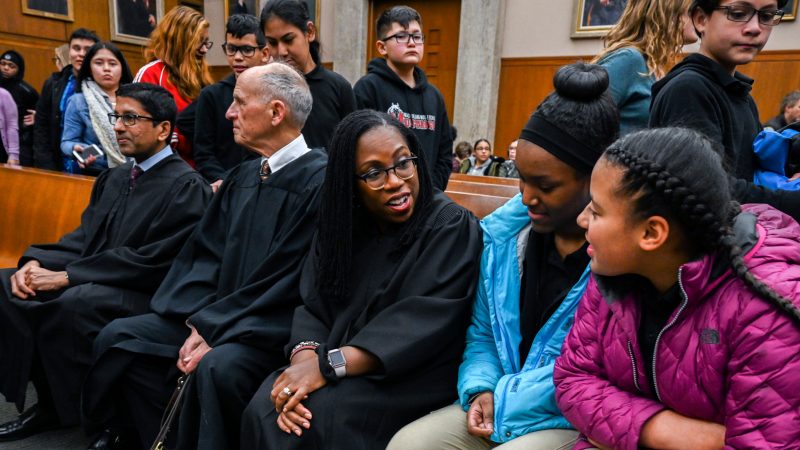You have been tasked with preparing the goody bags for a child’s birthday party. The hosts would like each bag to contain a roughly equal number of lollipops, candy bars and stickers.
You start grabbing things from a bowl and stuffing them into bags before you realize that the bowl doesn’t have any lollipops in it. All you’ve been putting in the bags are candy bars and stickers. So you grab the bag of lollipops and start stuffing in suckers.
Then, a voice calls out. It’s Rep. Glenn Grothman (R-Wis.), infuriated that you’re so biased toward lollipops.
You will hopefully forgive my allegory bleeding over into reality. It was commentary offered by Grothman on the House floor on Thursday, though, that spurred the example.
“Apparently, his first two years, President Biden had appointed 97 federal judges. Of the 97 federal judges, I was expecting maybe 25 or 30 were White guys because I know President Biden wasn’t heavy on appointing more White guys,” Grothman complained. “Five of the 97 judges were White guys. Of those, two were gay. So almost impossible for a White guy who’s not gay to get appointed.”
What with all these lollipops being added, it’s almost impossible for a candy bar to get put into a goody bag! Except, of course, that those goody bags already have a disproportionate number of candy bars. And so it is with White guys on the bench.
Let’s assume that you think the judiciary should reflect the diversity of the country, as Biden does. It is easy to evaluate how close we are to that goal, thanks to the Census Bureau’s assessments of the composition of the population and to analysis of the bench. The American Constitution Society (ACS), for example, has an analysis of the racial and gender composition of the judges who “make up the U.S. Supreme Court, circuit courts, district courts, and the U.S. Court of International Trade.”
And here’s the comparison we get. Notice that we’ve added two measures of the country’s population: both its overall racial composition and the composition of adults (given that relatively few children end up with appointments to the federal judiciary). That orange bar on top — White judges — extends well past the orange bars in the middle and on the bottom because Whites make up a higher percentage of the judiciary than the population.
We can look at this another way. The graph below compares the percentage of judges in each racial group (on the vertical axis) with the percentage of the adult population each constitutes (on the horizontal axis). Any dot above the diagonal line represents a racial group that’s overrepresented in the judiciary — and the farther from the line it sits, the larger that overrepresentation.
You can see that three groups are overrepresented: Native Americans, Blacks and Whites. But Native Americans (and Native Alaskans) are only barely overrepresented. Whites are overrepresented by six percentage points. Hispanics are underrepresented by eight points.
And that’s among adults! Non-White Americans tend to be younger than White Americans, so the imbalance is even more stark when comparing the judiciary to the population in general. Whites are overrepresented by 10 percentage points compared to the population overall.
That doesn’t break out gender. When we do, we see an even more immediately obvious disproportion.
Remember that we’re assuming that you think the judiciary should reflect the diversity of the country. The question, then, is how to fix the imbalance demonstrated above.
You could, as Barack Obama did, make appointments that more closely reflect the population, hoping to slowly adjust the judiciary to align with the population. The ACS estimates that 64 percent of Obama appointees were White and 58 percent men, both lower than the existing percentages of those groups in the judiciary.
And then Donald Trump showed up. Eighty-four percent of his appointees were White and 76 percent were men. The ratio got skewed back the other way very quickly.
If we extend our goody-bag analogy, you could even out the bags by shifting to putting six lollipops in for every three candy bars. But all that does is slow down the effort to reach the proper balance and — remember — you’ve only got a little bit of time to reach your goal. So you could be forgiven for simply trying to balance things out more quickly.
Especially since there’s a guy who keeps offering to help — asking when he can have a turn — who’s wearing a T-shirt saying “Lollipops kill.”
Bringing up the other point: Maybe you don’t think that the judiciary should reflect the country. Maybe you think there’s no difference in the experiences and values of men and women or White and Hispanic people. Perhaps you think that the engine for so many White men graduating from elite universities and getting jobs clerking for high-profile judges is merit. In that case, none of this math matters because it reflects an effort to which you’re indifferent.
It’s not clear from Grothman’s argument where he falls on this divide. But it is clear that he views Biden’s efforts with disdain — that he was prepared to view them with disdain before seeing the numbers but had more disdain afterward. So he decided to make it part of his speech.
This is revealing about an existing undercurrent in American politics. Efforts to address imbalances on race and gender, to fix examples of bias, are presented as themselves being examples of bias. It’s inverting the blame: You’re appointing too many non-White judges! — after a disproportionate number of White judges have already been confirmed to the bench. You’re trying to increase turnout among non-White voters! — after systemic imbalances have already ensured a more-White electorate.
You’re only adding lollipops! — after the goody bags are already out of whack. You can’t fix a problem without fixing it.
And that’s assuming you want to fix the problem.








